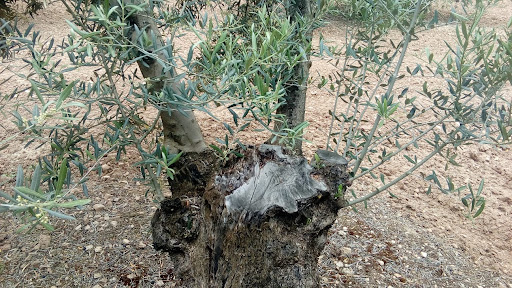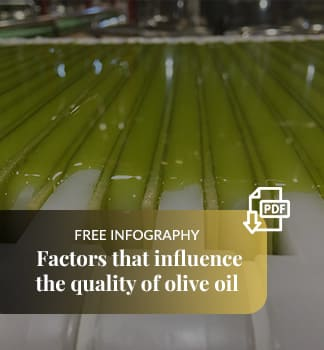Listen to this article
In the first place, what we have to know before talking about the differences between the different types of pruning is that the hierarchical premises that govern pruning are:
- Adapt the structure of the olive tree to the way of harvesting
- Maximize lighting
- Maximize the leaf / wood ratio
- Adjust the size of the glass to the water and light reality of the farm.
Although when the olive grove is pruned, all these principles are taken into account at the same time, for informative purposes, we speak of formation pruning, production pruning and renewal pruning, as subdivisions of the pruning itself.
Let's see each one on which principles it focuses and what it consists of.
Formation pruning
The young olive tree, born either by sexual or asexual reproduction, tends in its youth to the bushy, multi-stem form, making harvesting and handling extremely difficult.
Formation pruning consists of shaping the olive tree from its plantation, towards the architecture that best suits the future form of harvesting, as well as the rest of the work and the environment.
Newly planted olive trees. ESAO Image Bank
Training pruning focuses mainly on the premise number 1 of pruning, of adapting the olive tree to harvest, although it also takes into account the premises 2 (Maximize lighting) and 3 (Maximize the leaf / wood ratio) when the cup is already being acted upon.
Olive trees have traditionally been formed either on several legs or on a single foot, and even on several legs to gradually reduce to a single foot.
Nowadays, in the new plantations, single-foot olive groves are sought for harvesting with vibro or umbrellas, or olive groves on trellises, for harvesting with the riding harvester machine.
For harvesting by vibration of the trunk, a tree design similar to that of the rest of the fruit trees is sought, with a single robust trunk, with the cross over 1 meter high, and in which between 2 and 4 main branches are inserted. This structure is easily harvestable while allowing a good distribution of the branches and production.
For this, from the plantation, they are eliminating, slowly but surely, all the branches that come out of the trunk below that height of the cross of one meter.
Above the withers, no action will be taken until the trunk is perfectly defined, and the crown already has a certain density, volume and globose shape, having already begun to produce the first important crops.
In the crown, also slowly, the best placed branches, with the best angle, will be selected to be the future branches of life, eliminating the very centered and vertical and the internal and pendulous ones.
For the olive grove in a hedge, the formation is simpler, since the shoots of the trunk below approximately 50 cm from the ground are also gradually eliminated, but initially the crown is not affected, since these actions will already be included in the production pruning.
Production pruning
Olive tree with production pruning. ESAO Image Bank
Once the olive tree has passed the juvenile phase, has its desired structure, and is in full production, it is desired to maintain this state, and as always, making the harvesting as efficient as possible.
Production pruning is based above all on premise number 2, of optimizing lighting, but it also takes into account the other premises in the background.
Olive tree in which thinning pruning has been carried out mainly. ESAO Image Bank
An olive tree already formed, if it is stopped pruning, looks for a state similar to the wild one, with a very dense crown, defoliated inside, with alternating productions housed only in the external part of the crown, of fruits of mediocre quality, being the accumulated production in series of at least 2 years, very improvable.
With the production pruning, the aim is to maintain an olive tree with a low crown density, capable of producing high and relatively constant harvests, with fruits of high caliber and high fat yield.
To do this, the branches that shade the rest of the crown the most are eliminated, which would be the thick internal and vertical branches, as well as the worst illuminated, which would be the branches of little internal and low vigor, which are defoliated. and they produce few and poor quality fruits.
To comply with premise 1 of facilitating harvesting, pruning will be different depending on the harvesting system used.
The premise 3 of the leaf / wood relationship is fulfilled by eliminating poorly lit and defoliated branches, while always looking for the crown to maintain its size with the fewest possible number of branches, eliminating parallel branches, in order to favor growth. horizontal shoots, the ones that contribute the most to olive production.
Olive tree with poor pruning due to an excessive number of main branches.
For premise 4 of the size of the olive tree, the intensity of pruning will be regulated, leaving more or less size and crown density depending on the farm.
The production pruning of the olive grove in hedge, follows its own protocol, highly influenced by the premise 1 of adaptation to the harvest, since the harvesting machine requires a very specific design of the cup.
This protocol has several steps:
- Elimination of most of the more horizontal and pendulous branches below 1 meter in height, since the harvester is not capable of harvesting the olives below 50 centimeters above the ground.
- Elimination of branches of a certain thickness and horizontality that penetrate significantly into the streets, as they will be greatly damaged by the combine, while there is a risk that the rest of the tree will suffer when the machine hooks and pulls these branches.
- Gradual elimination of the more central, high and vertical branches, as they shade the rest of the crown and also conflict with the harvesting machine. In addition, they are the ones with the worst leaf / wood ratio, after poorly lit low twigs.
- Some later thinning, if the hedge is still excessively dense, renovations, etc.
To prune the super-intensive olive grove, mechanical and manual pruning is combined.
Renewal pruning
An unpruned olive tree that is allowed to grow freely in height, preserves an acceptable leaf / wood ratio in its branches: although it has a leaf only on the outside of the branches, it does not have thick sections of peeled wood emitting suckers.
Olive tree in which after a couple of campaigns without pruning, it has reached a very dense crown status, similar to that of a wild olive tree.
In the usual pruning of the olive tree and in general in that of the rest of fruit trees, the tendency is to eliminate the more central and vertical branches of the crown, both those that come directly from the crown, as well as those that come out from other thicker branches.
This technique seeks on the one hand to illuminate the internal part of the glass, while not leaving the olive tree with an excessive height to which the operators cannot reach in the shaking and the pruning itself.
This pruning to eliminate internal and vertical branches, when it is done on branches born on main branches, damages the leaf / wood ratio of said main branches on which it is carried out, as it leaves long sections of thick wood without thin branches rich in leaf .
On these thick wood sections, in addition, suckers are born, which at first do not substantially improve the leaf / wood ratio either, but which do compete for sap and light with the rest of the productive branches.
Very poor pruning, consisting of eliminating all branches and suckers in the center of the crown, with the consequence of a drastic decrease in the leaf-wood ratio, great emission of suckers, burning of the branches, etc.
To compensate for this problem of the loss of the wood / leaf relationship of the branches over time, which is colloquially called aging of the branches, renewal pruning is used, which above all responds to premise number 3 of pruning, the to maintain the best possible blade / wood ratio.
Within the renewal pruning, two variants can be distinguished, which in practice are carried out at the same time, giving more importance to one or the other depending on the case:
1.- Direct renewal on the cross.
It consists of eliminating complete branches from their insertion to the trunk, with the intention that other new branches sprout in the same place, which over time occupy the same space as the illuminated branch, but with a better leaf / wood ratio and therefore so much better production.
It must be carried out exclusively by qualified personnel, as it can easily damage the production and structure of the tree in an irreversible way, since there are many factors involved in its execution.
It can lead to significant temporary productive losses.

Head renewal pruning on a 3-foot centennial olive tree stand. You can see on the right of the photo how a complete branch was eliminated 2 years ago, and that from this cut new branches are sprouting that in the future will cover the productive gap left by eliminating the original branch
2.- Renovation on main branches.
The development of young branches inserted on top of other older branches is facilitated, which are called secondary renewals.
It is achieved with the thinning of the suckers that come out mainly from thick horizontal sections.
They make it possible to maintain a good leaf / wood ratio in the trees, without the significant production losses that direct renewal on the cross can entail.
Both types of renewal are always simultaneous in the pruning of the olive tree, although depending on factors such as the variety, age, frame, soil, climate, etc., one or the other technique will be prioritized.
The renewal pruning itself is not necessary in the hedgerow olive grove, as long as the thinning or production pruning has been carried out with a view to prioritizing the presence of the best placed young branches. If an olive grove is found in an aged hedge, with a low leaf / wood ratio, it is necessary to carry out pruning of a certain severity to favor the birth and development of new branches, which leads to immediate production losses.
We therefore see the importance of knowledge in the different types of pruning, training to distinguish the objectives of each one, as well as the correct performance of each one of them.
In the Olive Grove Management and Pruning module within the Master Olive Oil Consultant Certification we will be able to become more and more professional in the correct management of the olive grove. In this way, we will improve productivity.
.png)




